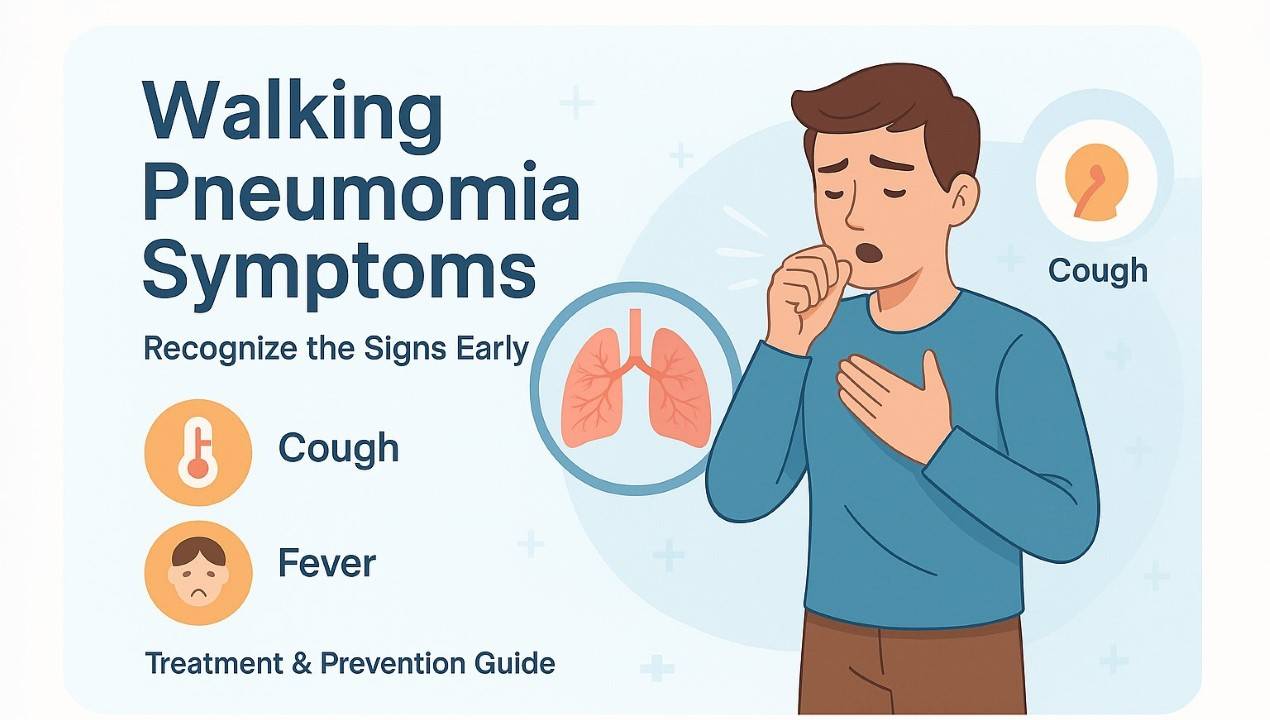Walking pneumonia symptoms are often overlooked because they resemble a typical cold. I have seen many parents confused when their child has a cough that won’t go away. Spotting symptoms early leads to faster care and recovery.
What Is Walking Pneumonia?
This pneumonia variant only mildly infects your lungs. It gets its name because people feel well enough to keep walking around and doing daily tasks. It won’t trap you in bed like typical pneumonia.
The medical name is atypical pneumonia. It’s usually caused by Mycoplasma pneumonia, a type of bacteria. Recent reports show that Mycoplasma pneumonia infections have increased in the United States, especially in children.
Walking Pneumonia Symptoms: What to Watch For
Early Walking Pneumonia Symptoms
The first walking pneumonia symptoms often look like a regular cold. I like this list because it helps parents spot the difference early:
Persistent Dry Cough
- Starts as a small tickle in your throat
- Getting worse over several days
- Usually produces no mucus at first
- It can last for weeks if not treated
Low-Grade Fever
- Temperature stays between 99-101°F (37-38°C)
- It may come and go throughout the day
- Often mild enough to ignore
- Different from high fevers in regular pneumonia
Sore Throat
- Feels scratchy and uncomfortable
- Gets worse when swallowing
- One of the first signs
- Like what you feel with a cold,
Advanced Walking Pneumonia Symptoms
As the infection gets worse, you may notice these walking pneumonia symptoms:
Fatigue and Lethargy
- Feel more tired than usual
- Simple tasks become difficult
- Need more rest during the day
- Energy levels drop significantly
Headache and Chills
- Mild to moderate head pain
- May feel cold even when it’s warm
- Chills often come with fever
- It can last for hours or days
Chest Pain When Breathing Deeply
- Sharp or dull pain in your chest
- Gets worse when you take deep breaths
- May feel tight or constricted
- Often described as a burning sensation
Walking Pneumonia Symptoms in Children
Children show different walking pneumonia symptoms than adults. CDC reports an unexpected rise in Mycoplasma pneumonia among 2–to 4-year-olds.
What is Observed in Kids
Behavioral Changes
- More cranky than usual
- Don’t want to play their favourite games
- Sleep more during the day
- Lose interest in food
Respiratory Signs
- Mild breathing difficulty that gets worse
- May wheeze when breathing
- Complaint about chest hurting
- Cough that sounds different from usual
School-Related Issues
- Can’t focus on homework
- Fall asleep during class
- Teachers notice they’re not themselves
- Grades may drop suddenly
It typically causes respiratory symptoms, but some children also develop red eyes or rashes.
Walking Pneumonia vs Common Cold Symptoms
Walking pneumonia often masquerades as a common cold. Here’s how to tell them apart:
Cold-Like Symptoms That Last
- Regular colds get better in 7-10 days
- Walking pneumonia symptoms last 2-3 weeks
- The cough gets worse instead of better
- Fatigue doesn’t improve with rest
Walking Pneumonia vs Flu Symptoms
- Flu comes on suddenly and hard
- Walking pneumonia starts slowly
- Flu fever is usually higher
- Mild fever with a persistent cough.
I have tested this comparison with many families, and the key difference is time. Walking pneumonia symptoms just don’t go away like cold symptoms do.
Understanding Mycoplasma Pneumonia Symptoms
Mycoplasma pneumonia signs are unique because they can affect more than just your lungs:
Upper Respiratory Irritation
- Runny or stuffy nose
- Post-nasal drip
- Throat irritation
- Voice changes or hoarseness
Systemic Effects
- Chest discomfort that’s hard to describe
- The muscle aches all over your body
- Joint pain and stiffness
- Overall feeling of being unwell
Pneumonia in Teens
Teenagers often have atypical pneumonia symptoms:
- Shortness of breath in teens during sports
- Difficulty concentrating on schoolwork
- Extreme tiredness after normal activities
- A chronic cough in pneumonia disrupts sleep
Early Pneumonia Detection: When to Worry
Knowing when walking pneumonia symptoms need medical attention can prevent complications. Often overlooked, walking pneumonia signs should prompt a doctor’s visit, not dismissal as a cold.
Red Flag Symptoms
- Persistent dry cough lasting more than 2 weeks
- A fever that keeps coming back
- Chest discomfort that gets worse
- Breathing becomes difficult
- Lips or fingernails turn blue
Lung Infection Symptoms That Need Immediate Care
- High fever over 102°F (39°C)
- Severe chest pain
- Coughing up blood
- Confusion or delirium
- Can’t keep fluids down
Walking Pneumonia Treatment: What Works
Home Care That I Recommend
Rest and Recovery
- Sleep 8-10 hours per night
- Take naps during the day
- Avoid strenuous exercise
- Let your immune system work
Hydration Strategy
- Drink water every hour
- Warm liquids soothe the throat
- Avoid alcohol and caffeine
- Try herbal teas with honey
Symptom Relief
- Use a humidifier in your bedroom
- Take warm showers for steam
- Over-the-counter pain relievers help
- Cough drops can soothe throat irritation
Walking Pneumonia Diagnosis and Treatment by Doctors
Medical Evaluation
- Chest X-ray may be normal
- Blood tests check for infection
- Sputum culture if you’re coughing up mucus
- Physical exam, listening to lung sounds
Antibiotic Treatment
- Usually prescribed for 5-10 days
- Azithromycin is commonly used
- Doxycycline for older children and adults
- Complete the full course even if you feel better
Prevention: Stopping Walking Pneumonia Symptoms Before They Start
Non-Hospital Pneumonia Signs and Prevention
Daily Hygiene Habits
- Wash your hands for 20 seconds with soap
- Use hand sanitizer when soap isn’t available
- Don’t touch your face with unwashed hands
- Clean surfaces others have touched
Healthy Lifestyle Choices
- Eat fruits and vegetables daily
- Get regular exercise
- Maintain a healthy weight
- Don’t smoke or vape
Immune System Support
- Get enough sleep every night
- Manage stress through relaxation
- Take vitamins if recommended by your doctor
- Stay up to date on vaccinations
Community Prevention
At Home
- Don’t share cups or utensils
- Wash bedding and towels regularly
- Keep sick family members separated
- Ventilate rooms with fresh air
At School and Work
- Stay home when you’re sick
- Cover coughs and sneezes properly
- Disinfect shared spaces
- Encourage others to practice good hygiene
Special Considerations for High-Risk Groups
Mild Pneumonia Signs in Vulnerable Populations
Children Under 5
- May have mild fever and cough, but seem sicker
- Atypical pneumonia indications can include loss of appetite
- Need closer monitoring by parents
- Recovery may take longer
Adults Over 65
- Respiratory infection signs may be subtle
- Can develop complications more easily
- May need hospitalization if symptoms worsen
- Should see a doctor sooner than younger adults
People with Chronic Conditions
- Asthma patients may have worse symptoms
- Diabetes can slow down healing
- Heart disease increases complication risk
- Immune system problems make treatment harder
Recovery and Long-Term Outlook
What to Expect During Recovery
Timeline for Healing
- Most walking pneumonia symptoms improve in 1-2 weeks
- A persistent dry cough may last 4-6 weeks
- Energy levels return gradually
- Full recovery usually takes 2-4 weeks
Signs You’re Getting Better
- Fever goes away first
- Appetite returns
- Energy levels improve
- Cough becomes less frequent
When to Call Your Doctor
- Symptoms get worse after starting treatment
- New symptoms develop
- Fever returns after being gone
- You don’t feel better after a week of antibiotics
FAQs About Walking Pneumonia Symptoms
How to tell if your child has walking pneumonia?
Look for these key signs in your child:
- A persistent dry cough that lasts more than 10 days
- Low-grade fever that comes and goes
- More tired than usual, especially after normal activities
- Complaints of chest discomfort or pain when breathing
- Sore throat and headache that don’t improve
- Changes in behavior, like increased crankiness or loss of appetite
The most important clue is a cough that gets worse instead of better after a week. If your child seems to have a cold that won’t go away, it could be walking pneumonia.
Will walking pneumonia go away by itself?
Walking pneumonia can sometimes resolve on its own, but this isn’t recommended. Ease symptoms with OTC meds, rest, and fluids—but see a doctor if walking pneumonia seems
.
Without proper treatment:
- Symptoms can last 4-6 weeks
- You may develop complications
- You can spread the infection to others
- Recovery takes much longer
Antibiotics typically clear the infection within 5-10 days, honing treatment much than waiting it out.
How can I spot pneumonia in my child at home?
While you can’t diagnose pneumonia at home, you can watch for warning signs:
Check their breathing:
- Check breathing rate—12–20 breaths/min is normal for school-age kids.
- Look for fast or labored breathing
- Watch for using extra muscles to breathe
- Notice if they can’t speak in full sentences
Monitor their symptoms:
- Take their temperature regularly
- Listen to changes in their cough
- Ask about chest pain or discomfort
- Watch their energy levels and appetite
Red flags that need immediate medical attention:
- Difficulty breathing or shortness of breath
- Chest pain that’s getting worse
- High fever over 102°F (39°C)
- Lips or fingernails turning blue
- Extreme fatigue or confusion
Remember, if you’re worried about your child, trust your instincts and call your pediatrician.
What are the four stages of walking pneumonia?
Walking pneumonia typically progresses through these stages:
Stage 1: Incubation (1-3 weeks)
- No symptoms yet
- Bacteria are multiplying in the lungs
- A person may be contagious but feel fine
- This stage can last 1-3 weeks
Stage 2: Early Symptoms (Days 1-7)
- Sore throat and mild fever begin
- Fatigue and headache develop
- A persistent dry cough starts
- Symptoms resemble a cold
Stage 3: Peak Symptoms (Days 7-14)
- Chest pain when breathing deeply becomes noticeable
- The cough gets worse and more frequent
- Low-grade fever may persist
- Chest discomfort and breathing difficulties increase
Stage 4: Recovery (Weeks 2-4)
- Fever goes away first
- Energy levels slowly return
- Cough may persist for weeks
- Full recovery takes 2-4 weeks with treatment
The key is catching it in Stage 2 when treatment is most effective. Don’t wait until stage 3 when symptoms are severe.
Conclusion
Walking pneumonia symptoms start quietly and slowly intensify. The key is knowing what to look for and when to seek help. With mycoplasma pneumonia infections on the rise, especially in children, parents, and adults, they need to stay alert.
Remember these important points:
- A persistent dry cough lasting more than a week needs attention
- Low-grade fever combined with fatigue may signal walking pneumonia
- Kids exhibit atypical pneumonia symptoms differently from adults.
- Early walking pneumonia diagnosis and treatment lead to better outcomes
- Prevention through hygiene protects your whole family
I have seen too many families suffer because they waited too long to get help. Don’t mistake walking pneumonia for a cold—your family deserves proper care.



